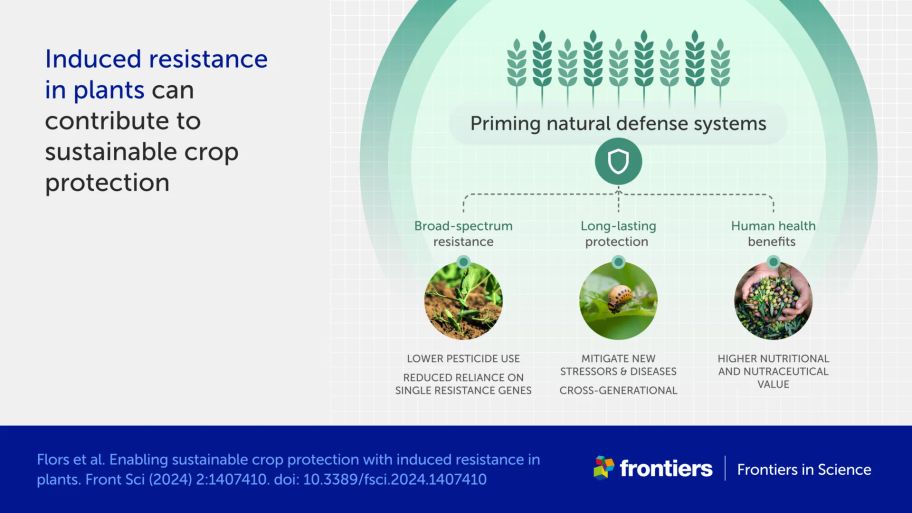Enabling sustainable crop protection with induced resistance in plants
Explainer
Front Sci, 15 October 2024
This explainer is part of an article hub, related to lead article https://doi.org/10.3389/fsci.2024.1407410
Induced resistance in plants: a strategy for more sustainable agriculture
Today’s intensive agricultural system relies on two main strategies for protecting crops from pests and disease: heavy use of pesticides, and planting crop varieties that have been bred or genetically engineered to contain a resistance gene against a particular insect or pathogen. Neither strategy is sustainable in the long term. Excessive use of pesticides damages the environment, harms human health, and significantly contributes to global greenhouse gas emissions. In addition, insects and microbes can evolve to overcome both strategies, which reduces or even eliminates their long-term effectiveness.
What if we could make plants more resistant to pests and pathogens in the first place? Enter “induced resistance in plants”—a technique that enhances plants’ natural immune systems. In their Frontiers in Science lead article, Flors et al. outline the many benefits of this more sustainable strategy for crop protection and how it can be adopted more widely. This explainer summarizes the article’s main points.
What is induced resistance in plants?
Induced resistance (IR) is a natural way of enhancing plant resistance to pests and diseases. It works by exposing plants to certain stresses or stimuli that prime their immune system to respond more quickly and strongly to future attacks—similar to a vaccine.
Unlike pesticides, IR responses do not directly kill a pest or pathogen. Instead, IR strengthens the plant’s physical or chemical resistance by, for example, reinforcing its cell walls or increasing its production of antimicrobial compounds. This means IR cannot cure diseases, nor provide complete protection. Nevertheless, induced resistance is a valuable alternative to excessive pesticide use that can help achieve more sustainable and resilient agricultural systems—with the co-benefit of improving food quality too.
What triggers induced resistance in plants?
Exposure to various agents and stressors can strengthen plant immunity, including:
pathogenic microbes, such as viruses, bacteria, and fungi, or compounds from these microbes
beneficial microbes that colonize roots and leaves and function like probiotics for the plant
plant compounds released at the site of an attack or as a “cry out for help” from other organisms, and synthetic compounds that mimic their effects.
Commercial products are available for the application of beneficial microbes and active IR compounds to crops, both in the field and in greenhouses.
How can induced resistance make crop protection more sustainable?
Induced resistance offers several benefits that can contribute to more sustainable agriculture.
Broad-spectrum protection. By activating a plant's natural defenses, IR can provide protection against a wide range of pathogens and insect pests. This reduces the need for pesticides and can help control emerging pests and diseases faster than traditional breeding. It also provides an alternative in cases where no effective pesticides are available or their use has been (or will be) banned, or where no crop varieties with resistance genes are available.
Long-lasting protection. IR can last throughout a plant’s life, and in some cases even pass across generations. It also reduces the evolutionary pressure for pests and pathogens to evade pesticides and resistance genes, which can help maintain the long-term effectiveness of these strategies.
Increased resilience. Beneficial microbes used for IR can enhance plants’ tolerance for other stressors.
Tool for integrated pest management. Induced resistance can be used in combination with other eco-friendly practices, such as crop rotation and biological control of pests, that together provide a more holistic approach to crop protection.

How can induced resistance improve crop yield and quality?
Induced resistance can promote healthier plants with higher yields by reducing the overall pathogen load in crops. In addition, plants often produce higher levels of bioactive compounds when they activate their defense mechanisms. These compounds—such as polyphenols, carotenoids, flavonoids, and antioxidants—improve the nutritional quality, health benefits, and flavor of crops.
What are the next steps for widespread use of induced resistance?
Despite promising applications, use of induced resistance in crop protection has remained low. This is largely due to its complexity: IR comes from a complex network of developmental and environmental pathways, so its use is not as straightforward as breeding for a resistance gene or spraying a single pesticide.
The authors outline a framework for making induced resistance a widely accepted and effective strategy for crop protection.
Further research into IR mechanisms. A better understanding is needed of how different compounds activate IR, the optimal time, dose, and application mode for different stimuli, and how to increase the longevity of the IR effect. One particular area of interest is epigenetics. Understanding how IR is regulated by these DNA modifications, which change gene expression without altering the genetic code, could help strengthen its effect and heritability. Researchers must also explore how to achieve IR without causing significant trade-offs that affect crop yield, such as reduced plant growth or increased susceptibility to other environmental stressors.
Defining how external factors affect IR. A major challenge for IR is that environmental conditions, plant age, plant genetics, and other external factors can affect its efficacy, leading to limited reproducibility. Field trials and mathematical modeling can help unravel these intertwined factors, while studies into plant genetic variation may allow the selection of crop varieties with high IR levels.
Strengthening regulatory support. Legislative frameworks need to be harmonized across countries to establish clear guidelines on the quality and efficacy of IR products. Such regulations will ensure that IR products meet high standards, fostering confidence among farmers and consumers.
Providing incentives. Socio-economic studies are needed to identify drivers for the adoption of IR technologies in agriculture. Understanding the barriers and incentives for farmers will help guide strategies to promote IR usage.
Overall, the authors argue for induced resistance to form a central element of holistic crop protection—in which multiple strategies are combined to deliver tailored solutions for different contexts.